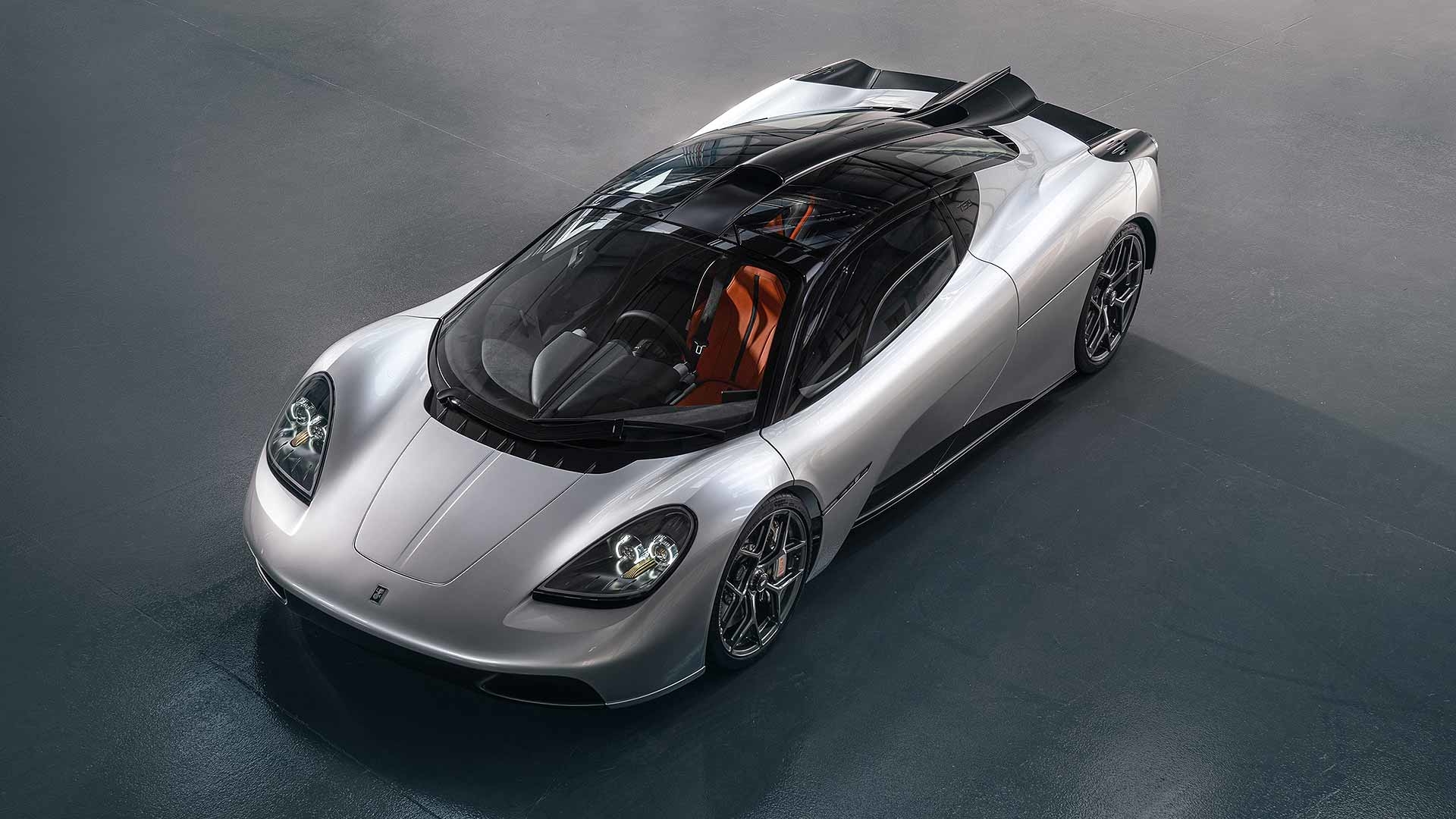
The Gordon Murray Automotive T.50 could be the best driver’s car of 2020. Maybe the finest driver’s car ever. Gordon Murray redefined things once, back in 1992, with the original McLaren F1. The T.50, his 50th car in 50 years of automotive design, aims to do that again. Murray vows never to build another supercar, so the T.50 could just be the purist benchmark of the breed forever more.
The spec is remarkable. It weighs just 986kg, or little more than a Lotus Elise. Yet has a 3.9-litre Cosworth V12 engine putting out 663hp, with not a turbocharger in sight. It revs to a ludicrous 12,100rpm, with a six-speed manual gearbox – rather than a paddleshift – adding to the intensity.
And it’s a fan car. Just like the Brabham BT46 Formula 1 car that infamously raced once, and won, before being banned. Gordon Murray designed that, too. The T.50 road car uses the same concept, with a big round fan at the rear that literally sucks the car to the ground with the ‘most advanced and effective aerodynamics ever seen on a road car’.
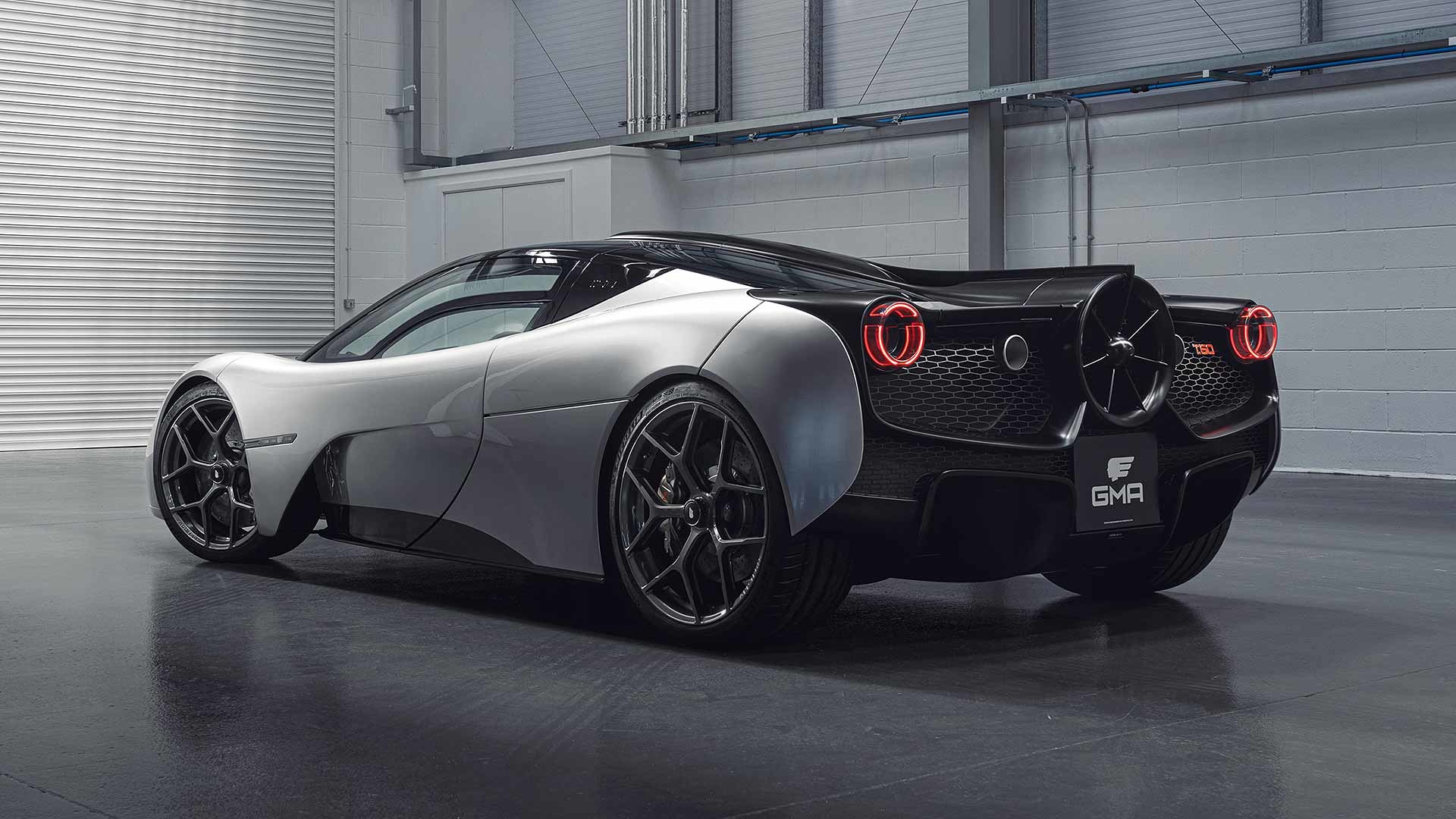
The son of F1 carries the family genes with its central driver’s seat and three-seat layout. It has nearly as much luggage space as a Ford Fiesta. It’s refined and relatively comfortable in everyday driving. It even has a bespoke high-end Arcam sound system that gets the seal of approval from famous audiophile Murray.
Priced from £2.8 million and set to be built from 2022, only 100 examples of the T.50 will be built. Here’s why the company believes this is the world’s most driver-centric car of all.
Fan zone
The fan is the talking point. There’s nothing else like it. The 400mm fan is the defining feature of the rear, with the centre of the car designed around it. It supports the functionality of dual active rear spoilers and interactive diffusers hidden underneath the car.
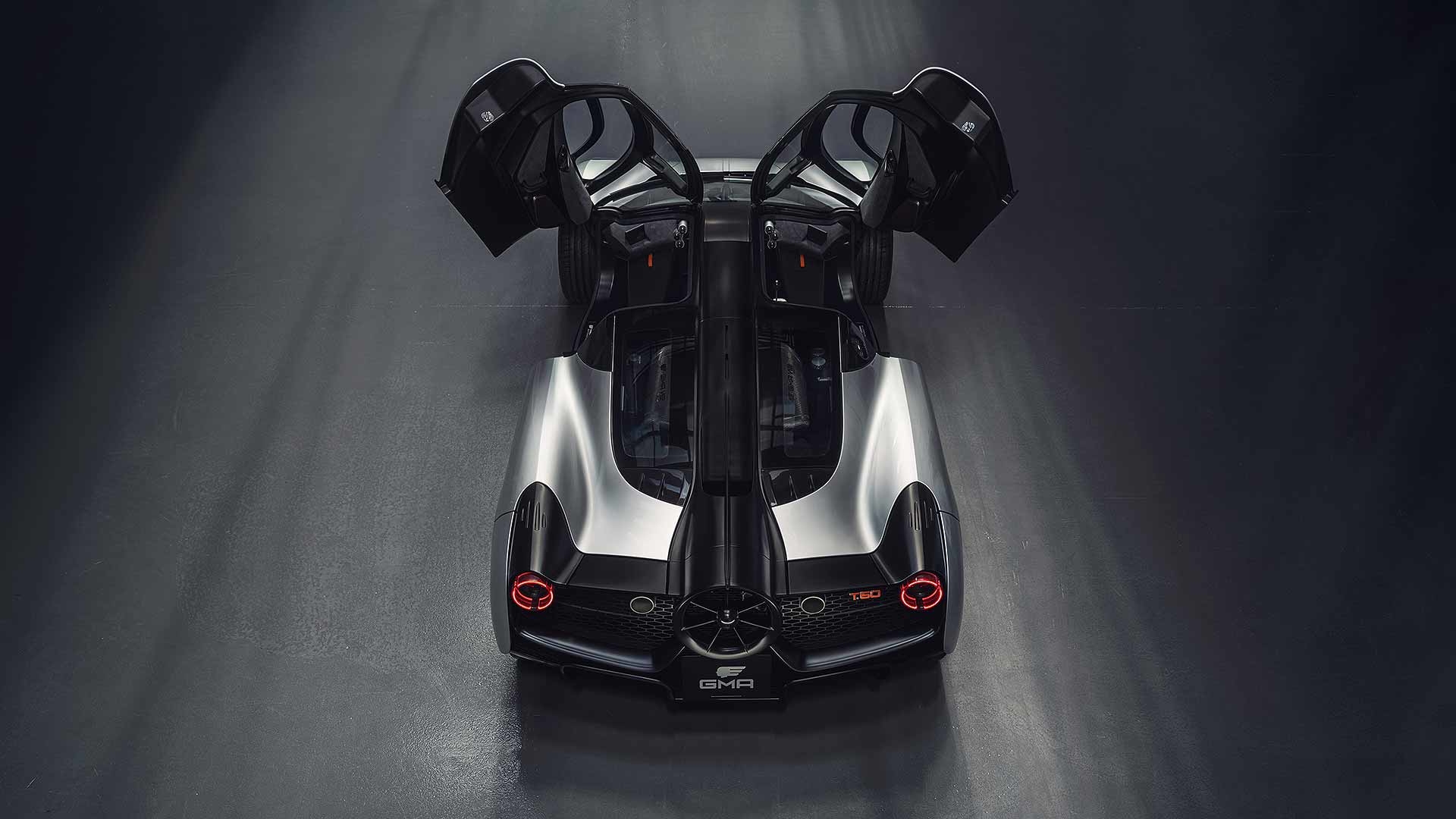
The idea of the fan is to speed up the flow of air passing below the body – something called ‘ground effect’. But it can also manage airflow over the top of the car, to balance downforce and drag. The fan is powered by a 48-volt motor that spins at up to 7,000rpm.
It all sounds mind-boggling, so let’s try to explain things via the six aero modes available:
· Auto: the default, where the fan has little effect
· Braking: again automatic, the rear spoilers are deployed to a maximum 45-degree angle, the fan operates at high speed and the diffuser valves open. The result is double the downforce and 150mph to zero in 10 metres less than normal.
· High Downforce: the first of four driver-selectable modes (via a controller on the left of the instrument pack), where the rear spoilers are deployed to +10 degrees, diffuser valves open and the fan spools. Result? 50 percent more downforce.
· Streamline: the rear spoilers are set to -10 degrees, diffuser valves partially close, while the fan operates at high speed, which draws air from the top of the car to reduce drag and create a ‘virtual longtail’ aerodynamic effect. That means 15kg of thrust and a 12.5 percent reduction in drag.
· V-Max Boost: the most extreme mode. This uses Streamline mode, but powers the fan by the 48-volt starter-generator, freeing up engine power. With added ram-air induction, it gives an output boost to 700hp.
· Test: the mode for showing off to your mates. When stationary, the fan spools up to maximum 7,000rpm, the twin rear spoilers cycle through their full range and the diffuser valves open and close before returning to rest. Cue the applause.
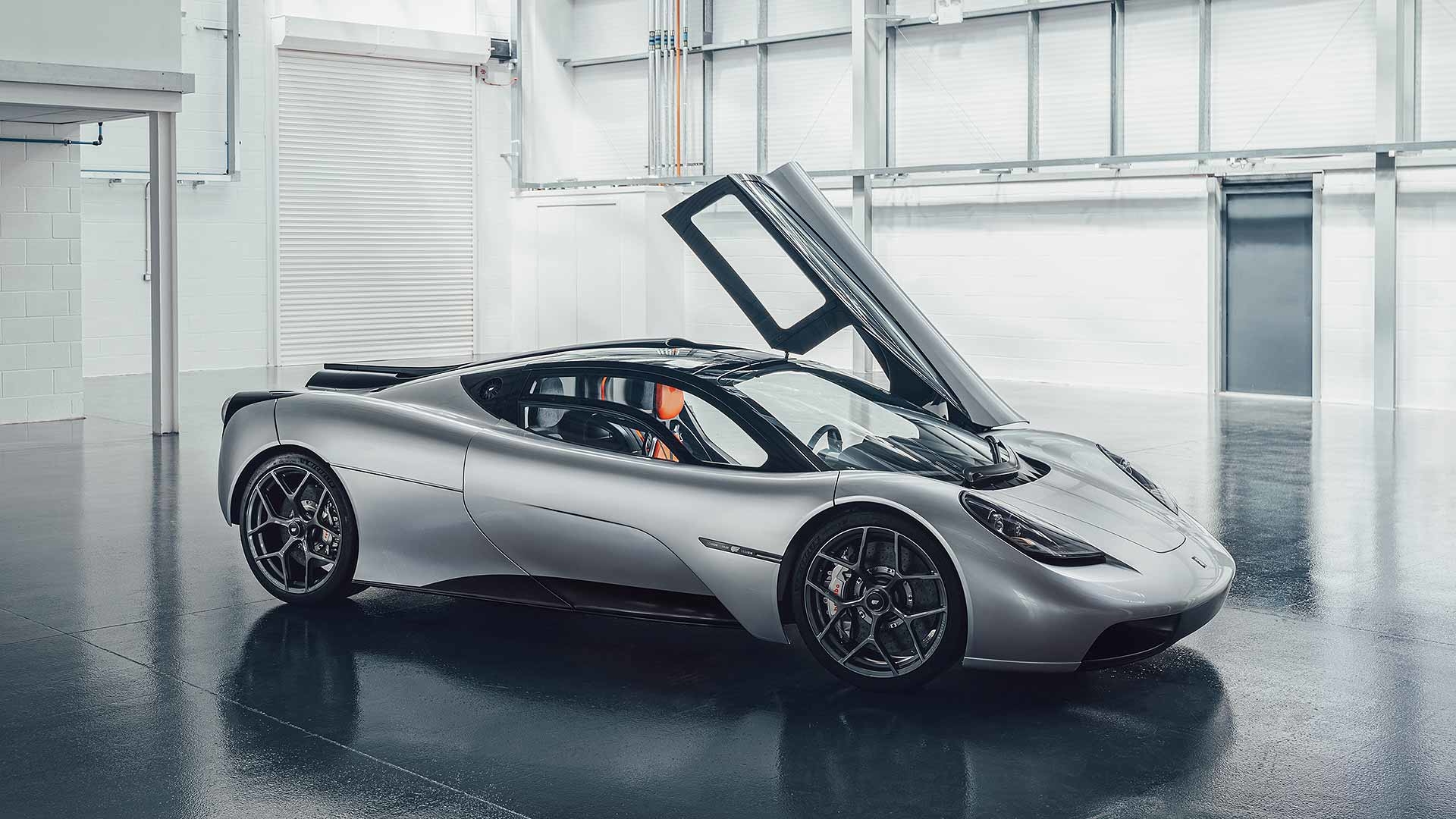
Light is right
The GMD T.50 will be one of the lightest new cars on the road, full stop. Thank a carbon fibre monocoque that weighs just 150kg, an engine that weighs 178kg and a gearbox that is 80kg. A typical supercar, according to Murray, weighs a third more – 1,436kg versus the T.50’s 986kg. A basic Ford Fiesta weighs 1,136kg.
Notably, the T.50 is 150kg lighter than the McLaren F1, which is going to make the experience of the world’s lightest, highest-revving V12 something extraordinary. The engine “was never going to be anything other than a V12,” says Murray. There’s nothing to match the response, sound, free-revving feel and turbo-free purity.
The Cosworth V12 will rev from idle to redline in 0.3 seconds: that’s a pickup speed of 28,400 revs per second. Yet it delivers over 70 percent of its pulling power from 2,500rpm. And, with ease of use in mind, there are actually two engine maps, with a more relaxed one limiting revs to 9,500rpm and power to 600hp, delivering the best efficiency and emissions.
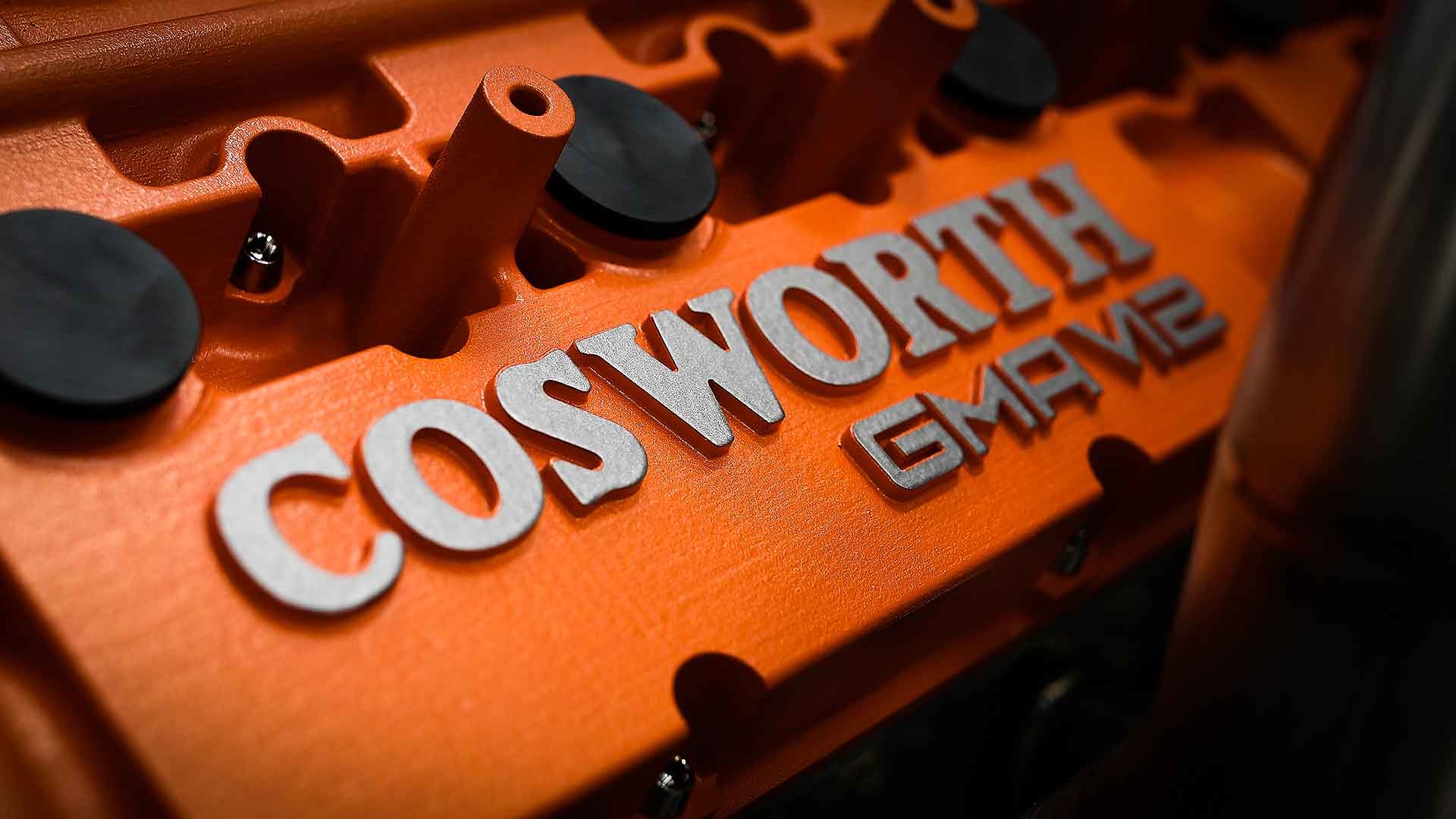
It’s also not covered beneath a plastic housing. Murray hates them. Instead, the orange cam covers, inlet trumpets and exhaust manifolds are on full display to wow everyone when the dihedral doors are opened.
Of course, it’s a six-speed manual, not a paddle shift, with an Xtrac gearbox boasting a narrow gate and short throw (with plenty of feel and control through solid titanium pedals). Murray says it provides “the ultimate gearchange”. He’d know: he signed it off personally.
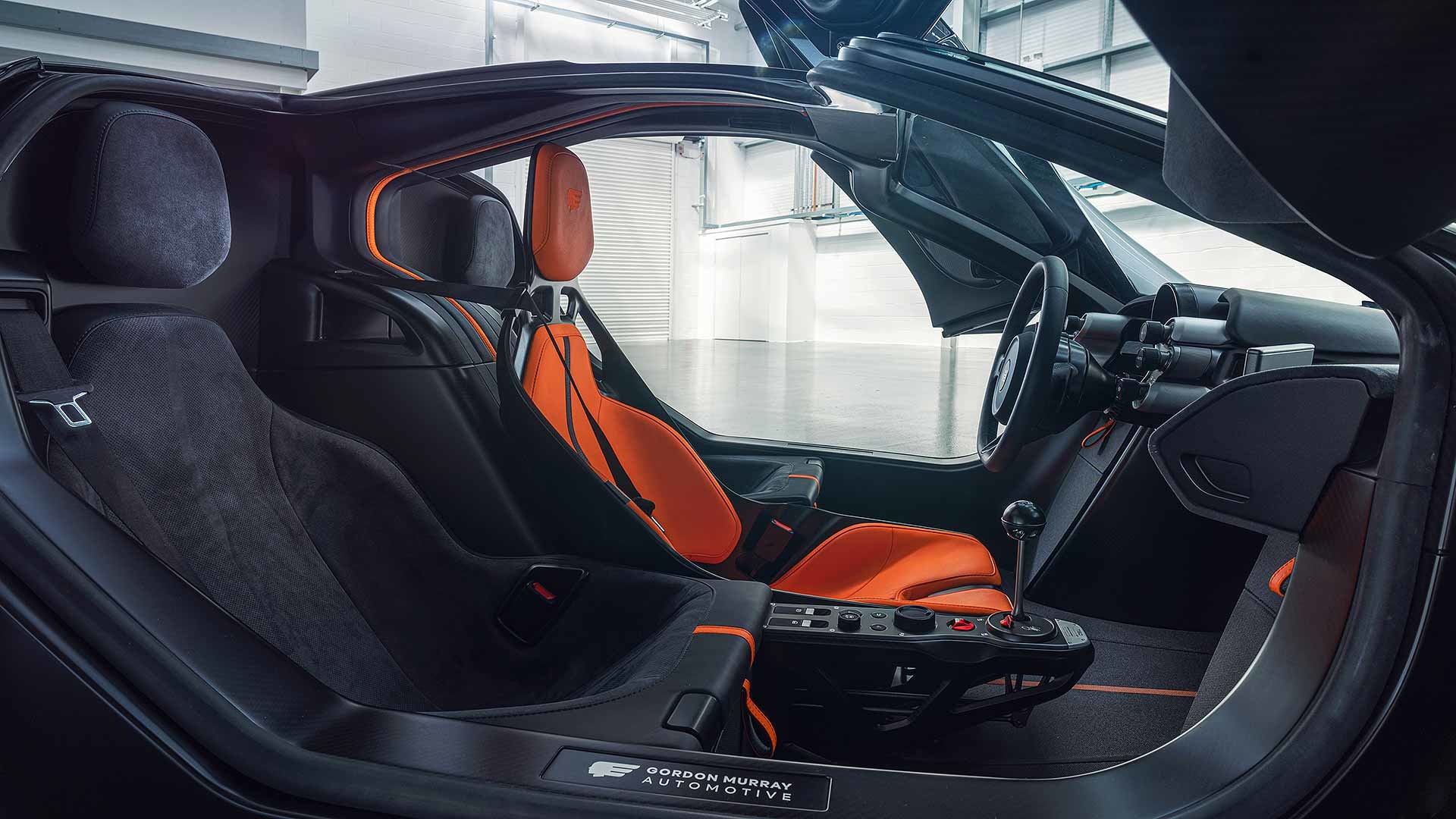
The everyday supercar
Gordon Murray has no time for awkward, inconvenient supercars. When he designed the McLaren F1, he bought a Honda NSX to provide inspiration, rather than the flawed Ferrari 348 equivalent. The F1 had three seats and decent luggage space; so too does the T.50.
In each rear haunch is a 90-litre space big enough for a flight case. If you only carry one passenger, there’s a special suitcase that fits into a passenger seat, boosting space to 288 litres. And there are five stowage bins in the cabin – two above the passenger footrests, two more under each passenger seat, plus a fifth behind the driver’s headrest.
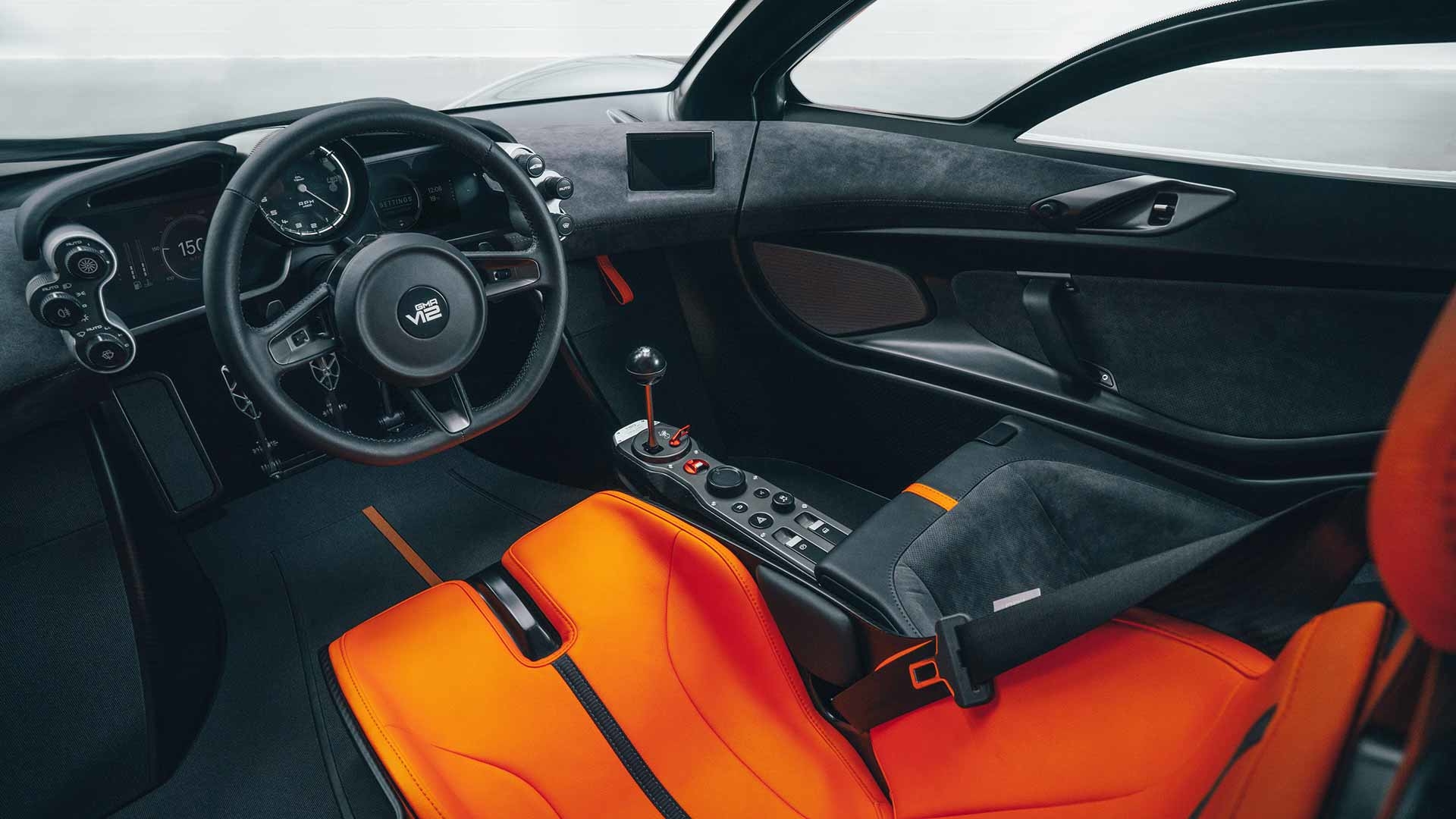
The T.50 is easy to get in and out of, despite its central seat (vividly coloured in contrast to the others, for max single-seater cues), visibility is said to be excellent, and the size of the car is manageable. It’s described as Porsche Cayman-sized, and so much wieldier in the city and on narrow roads than a regular supercar. It even has speed-bump-friendly ground clearance of up to 140mm.
There are no parts bin components here: it’s all bespoke, just as in the McLaren F1. Pride of place is given to the 120mm analogue rev counter, floodlit and with a milled aluminium needle. Aluminium is also used for the rotary controls that surround the instruments, while the right-hand display nods to modernity with a colour screen that includes Apple CarPlay and Android Auto. So too do the dual rear-view monitors either side of the cabin, which substitute for old-fashioned door mirrors.
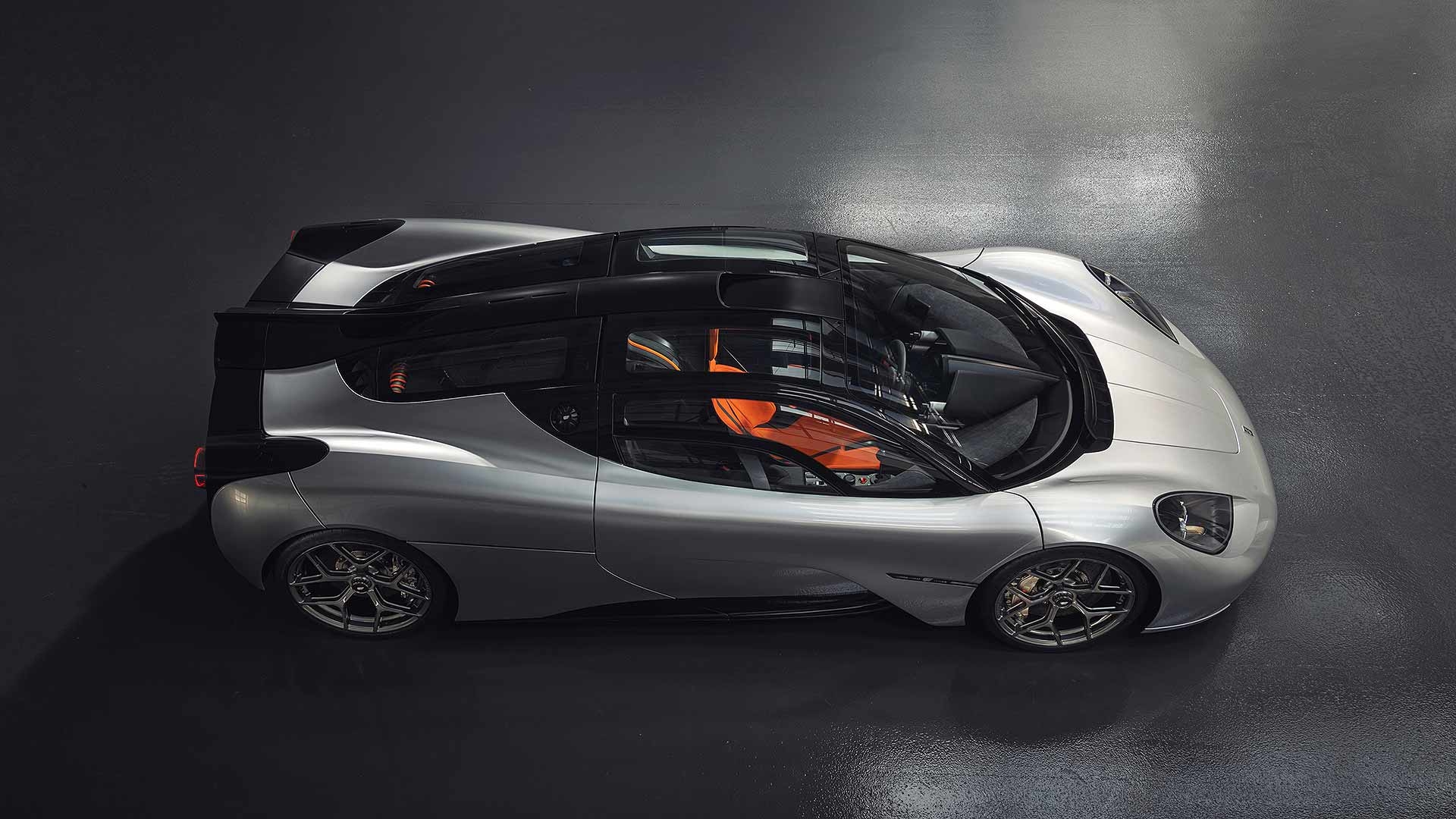
The timeless supercar
The effectiveness of the fan means the T.50’s aerodynamics are largely beneath the surface. It doesn’t need the exaggerated wings, vents and ducts Murray so dislikes. “I was determined to create a clean and pure shape that would remain timeless, ensuring the T.50 will still look fresh in 30 years.”
There’s a central line that stretches from the Gordon Murray Design mermaid badge on the nose, moving inside the cabin as it heads rearwards. Towards the back, it’s mirrored by a central spine running from the air intake into the top of the fan.
The LED headlights also nod to the McLaren F1, says Murray. They are also at least 15 percent brighter than any supercar that’s gone before. Then there’s the roof-mounted air inlet, which is pure McLaren F1. While the shape is simple, the rear deck has plenty of aero-influenced shaping, all to direct air towards the twin active spoilers.
Murray says the badge is “probably the oldest automotive logo in the world”. The Murray family first used it in the 12th century. Meanwhile, the blue, red and green colouring mirrors the Murray clan’s tartan.
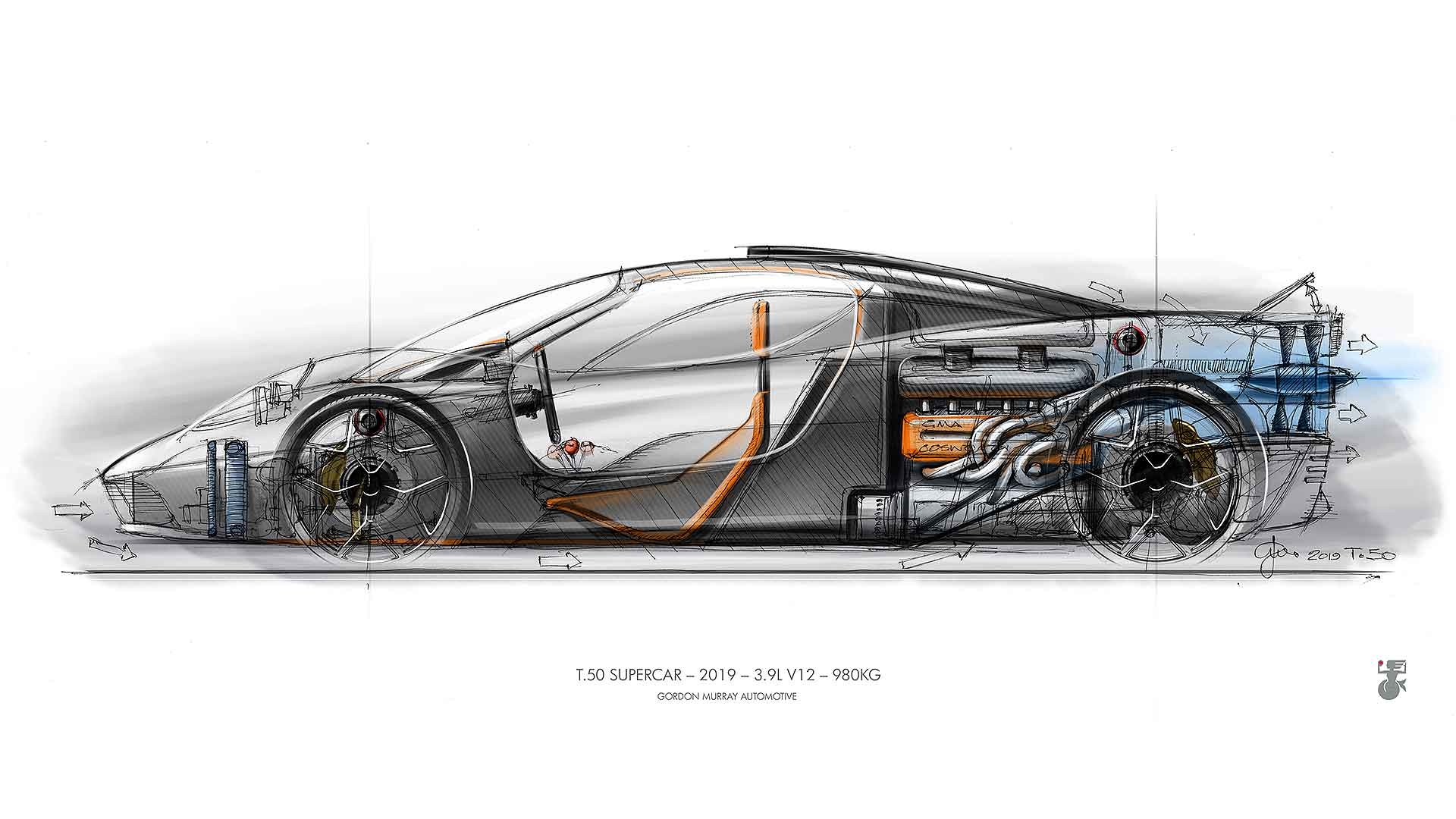
Simply extraordinary
The T.50 is pure Gordon Murray. Pure, yet intricately engineered without compromise, meeting extraordinary targets and promising plenty. As more and more cars take over from the driver, this is putting them back, literally, at the centre of the experience.
“The agility, responsiveness and reward of a lightweight vehicle simply cannot be matched,” says Murray. Lightness is his mantra. It’s why he drives an Alpine A110 today, after spending years in a Smart Roadster. It’s why weekly ‘weight watchers’ meetings were called, where the weight of components down to nuts, bolts and fixings was scrutinised.
We’re wowed by it already. The meticulous way Murray and his team have focused on creating not only the purest, lightest and most driver-centric supercar ever, but also one of the most refined, comfortable and usable too. It’s a ferociously exciting project. Yes, it’s almost £3 million, and still two years away, but if the promise revealed today is fulfilled in 2022, the McLaren F1 may yet have a genuine successor. And the world, out of nowhere, an all-new supercar benchmark. Maybe, just, THE petrol-engined supercar benchmark, ahead of the switch to electric.
Gordon Murray has done it once. With the T.50, can he do it again?
ALSO READ
Gordon Murray awarded CBE in 2019 New Year’s Honours
Gordon Murray’s online museum is virtually brilliant
The best motorsport liveries of all time
[…] could own five examples of the new Gordon Murray Automotive T.50 for the price of one McLaren F1. That’s according to the latest Hagerty Price […]
[…] that a Big Mac is bigger than you think. Although they meant the burger, the reverse applies to the McLaren F1, which always looks like it should be a large car. Actually, in terms of length, width, and […]